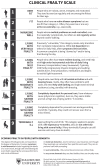Optimizing care for critically ill older adults
- PMID: 34607846
- PMCID: PMC8568082
- DOI: 10.1503/cmaj.210652
Optimizing care for critically ill older adults
Conflict of interest statement
Competing interests: None declared.
Figures



Similar articles
-
Polypharmacy and Delirium in Critically Ill Older Adults: Recognition and Prevention.Clin Geriatr Med. 2017 May;33(2):189-203. doi: 10.1016/j.cger.2017.01.002. Epub 2017 Mar 1. Clin Geriatr Med. 2017. PMID: 28364991 Review.
-
Delirium: an emerging frontier in the management of critically ill children.Crit Care Clin. 2009 Jul;25(3):593-614, x. doi: 10.1016/j.ccc.2009.05.002. Crit Care Clin. 2009. PMID: 19576533 Free PMC article. Review.
-
Delirium in critically ill patients.Handb Clin Neurol. 2017;141:449-466. doi: 10.1016/B978-0-444-63599-0.00025-9. Handb Clin Neurol. 2017. PMID: 28190430 Review.
-
Effect of a Three-Component Geriatrics Bundle on Incident Delirium among Critically Ill Older Adults: A Pilot Clinical Trial.Ann Am Thorac Soc. 2024 Sep;21(9):1333-1337. doi: 10.1513/AnnalsATS.202311-963RL. Ann Am Thorac Soc. 2024. PMID: 38785442 No abstract available.
-
Considerations in caring for the critically ill older patient.J Intensive Care Med. 2009 Mar-Apr;24(2):83-95. doi: 10.1177/0885066608329942. Epub 2008 Dec 28. J Intensive Care Med. 2009. PMID: 19114416 Review.
Cited by
-
Evolution and Effects of Ad Hoc Multidisciplinary Team Meetings in the Emergency Intensive Care Unit: A Five-Year Analysis.J Clin Med. 2024 Jul 24;13(15):4324. doi: 10.3390/jcm13154324. J Clin Med. 2024. PMID: 39124591 Free PMC article.
-
Impacts of antipsychotic medication prescribing practices in critically ill adult patients on health resource utilization and new psychoactive medication prescriptions.PLoS One. 2023 Jun 29;18(6):e0287929. doi: 10.1371/journal.pone.0287929. eCollection 2023. PLoS One. 2023. PMID: 37384760 Free PMC article.
-
The impact of age on mortality in the intensive care unit: a retrospective cohort study in Malaysia.Acute Crit Care. 2024 Aug;39(3):390-399. doi: 10.4266/acc.2024.00640. Epub 2024 Aug 12. Acute Crit Care. 2024. PMID: 39266274 Free PMC article.
-
Applying the geriatric 5Ms in critical care: the ICU-5Ms.Can J Anaesth. 2022 Sep;69(9):1080-1085. doi: 10.1007/s12630-022-02270-9. Epub 2022 Jun 10. Can J Anaesth. 2022. PMID: 35689016 No abstract available.
-
Factors Associated with Re-attendance at Emergency Departments Among Older Adults: A Cross-Sectional Analytical Study.Inquiry. 2025 Jan-Dec;62:469580251349652. doi: 10.1177/00469580251349652. Epub 2025 Jun 24. Inquiry. 2025. PMID: 40553440 Free PMC article.
References
-
- Care in Canadian ICUs: data tables. Ottawa: Canadian Institute for Health Information. Available: https://www.cihi.ca/en/care-in-canadian-icus-data-tables (accessed 2021 Aug. 18).
-
- COVID 19 daily epidemiology update. Ottawa: Public Health Agency of Canada; updated 2021 Sept. 3. Available: https://health-infobase.canada.ca/src/data/covidLive/Epidemiological-sum... (accessed 2021 Sept. 15).
-
- Joyce MF, Reich JA. Critical care issues of the geriatric patient. Anesthesiol Clin 2015;33:551–61. - PubMed
-
- Flaatten H, de Lange DW, Artigas A, et al. . The status of intensive care medicine research and a future agenda for very old patients in the ICU. Intensive Care Med 2017;43:1319–28. - PubMed
-
- Michels G, Sieber CC, Gernot M, et al. . Geriatric intensive care: Consensus paper of DGIIN, DIVI, DGAI, DGGG, ÖGGG, ÖGIAIN, DGP, DGEM, DGD, DGNI, DGIM, DGKliPha and DGG [article in German]. Z Gerontol Geriatr 2019;52:440–56. - PubMed
Publication types
MeSH terms
LinkOut - more resources
Full Text Sources
Medical
